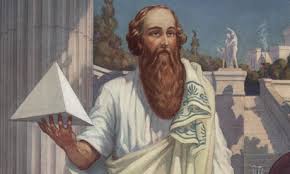Introduction
 Pythagoras, from Samos in Greece, was very dedicated to the study of anything mathematical.
Pythagoras, from Samos in Greece, was very dedicated to the study of anything mathematical.
Born in 569 BC, Pythagoras found fascination in poetry, philosophy, astronomy and music, aside of the general idea of mathematics of course. He had a mother named Pythais, around 2 or 3 siblings, married to a woman named Theano, had a daughter named Damo and a son named Telauges.
He proved that with any right triangle, if you have the measurements of 2 sides, you can figure out the length of the other side with a simple equation. This equation is a^2 + b^2 = c^2; hence the name Pythagorean Theorem after Pythagoras.
You live in Samos, Greece, and you are friends with Pythagoras who has sent you on a mission. You must find at least 5 objects that are right triangles, find the measurements of 2 of the sides, and find the missing length with Pythagorean Theorem.
Task
Where could you begin?
Start looking around. Notice that there are objects that are right triangles, and start to get creative. Maybe you could make a 3 dimensional shape with these objects? A flat shape such as a star?
What objects could you possibly use?
Anything that is tangible, measurable, and is a right triangle is perfect for this project. You may even use squares cut by their diagonal and create your shape with those. The more creativity involved, the more points given.
Process
You will need to find 5 objects that are right triangles you would like to use. They have to be tangible, easy to carry and able to bring into class. You may also use square/reactangle objects.
With each object, measure only two sides. You will work out each triangle with variety, for example, do not find the hypotenuse (c) with every triangle, find a leg, (a or b). You must solve each triangle and have a DETAILED explanation to go along with it. There has to be a way I can know which explanation goes to which triangle, for example, you could have a blue paper for the blue triangle, red for a red triangle, number the triangles, etc.
Once you have done these steps, this is where most of your points come into play. You must create a shape out of the triangles you have chosen, and creativity counts the most. You do not have to incooperate all of the triangles into the shape. This shape can be 2D or 3D, but it must hold together.
Evaluation
Use the following rubric to judge your project and to meet the criteria. You will be graded very hard and your project will be thoroughly looked at.
|
|
|||||
|
Criteria |
Basic |
Average |
Decent |
Excellent |
Points |
|
Neatness |
The student does not have a neat format in the work, explanations, and project itself. 5 pts |
The student has partial neatness but only in certain areas. 10 pts |
The student shows neatness but not above expectations. 15 pts |
The student shows neatness above expectations, possibly typed work and has in a neat order. 20 pts |
/20 |
|
Creativity |
Student creates a shape but it doesn’t hold together, it’s quite messy and is not creative. 10 pts |
The student’s shape is not very creative and does not hold together well. 20 pts |
The students shape holds but doesn’t go above expectations in creativity. 30 pts |
The student’s triangles, shape and explanations are very creative, neat, and different than other projects. 40 pts |
/40 |
|
Organization |
The student’s project is very messy, unorganized, and is not appealing to the eye. 5 pts |
The student is partially organized but lacks neatness in some areas. 10 pts |
The student has organization but it is not above expectations. 15 pts |
The student has very nice neatness and organization that is high above expectations with the entire project. 20 pts |
/20 |
|
Effort |
Not much effort is included in any area of the project. 5 pts |
The student shows effort but the explanations are weak and the project is missing things. 10 pts |
The student shows effort in their work but it is not above expectations and lacks neatness. 15 pts |
The student has typed explanations of each triangle and shows neatness, organization, and full effort on their entire project. 20 pts |
/20 |
|
|
|
|
|
Total -> |
/100 |
Conclusion
Pythagorean Theorem, created by Pythagoras, can be very useful. This project shows you that through right triangles, you can find the length of any side as long as you have 2 measurements. Right triangles are also in shapes like squares and rectangles by simply cutting them diagonally. Pythagorean Theorem can be used in many ways all around you in everyday life.
Credits
I created this project to not only open up eyes to things all around us, but to show the importance of Pythagorean Theorem. This can be used in many real life situations and be very useful. Finding random shapes around you and working through the equation with only 2 measurements proves this can be used in the real world. This project also sparks creativity and makes this fun to work through; exactly what projects in classes need to incude to build interest in students.